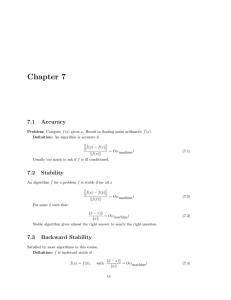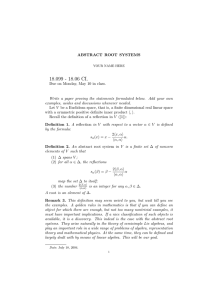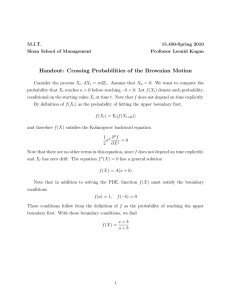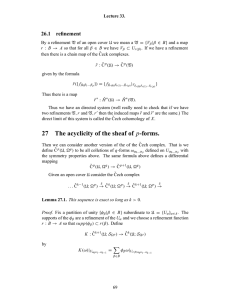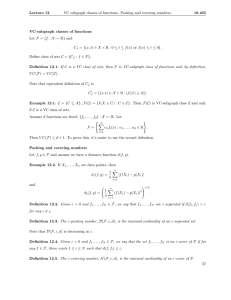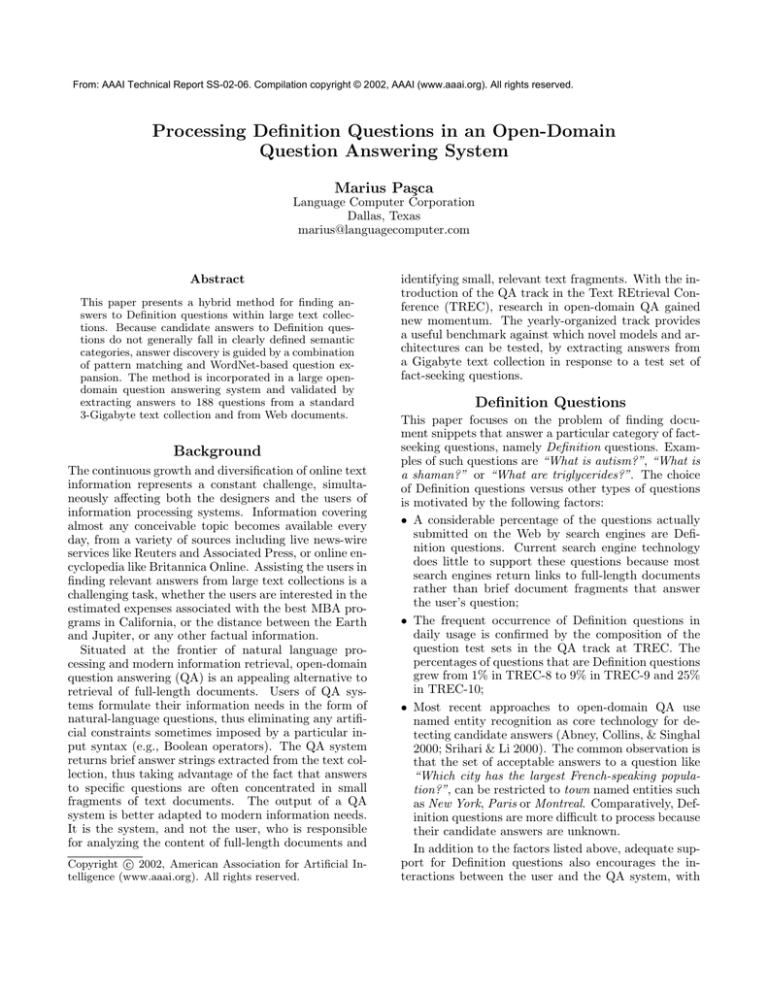
From: AAAI Technical Report SS-02-06. Compilation copyright © 2002, AAAI (www.aaai.org). All rights reserved.
Processing Definition Questions in an Open-Domain
Question Answering System
Marius Paşca
Language Computer Corporation
Dallas, Texas
marius@languagecomputer.com
Abstract
This paper presents a hybrid method for finding answers to Definition questions within large text collections. Because candidate answers to Definition questions do not generally fall in clearly defined semantic
categories, answer discovery is guided by a combination
of pattern matching and WordNet-based question expansion. The method is incorporated in a large opendomain question answering system and validated by
extracting answers to 188 questions from a standard
3-Gigabyte text collection and from Web documents.
Background
The continuous growth and diversification of online text
information represents a constant challenge, simultaneously affecting both the designers and the users of
information processing systems. Information covering
almost any conceivable topic becomes available every
day, from a variety of sources including live news-wire
services like Reuters and Associated Press, or online encyclopedia like Britannica Online. Assisting the users in
finding relevant answers from large text collections is a
challenging task, whether the users are interested in the
estimated expenses associated with the best MBA programs in California, or the distance between the Earth
and Jupiter, or any other factual information.
Situated at the frontier of natural language processing and modern information retrieval, open-domain
question answering (QA) is an appealing alternative to
retrieval of full-length documents. Users of QA systems formulate their information needs in the form of
natural-language questions, thus eliminating any artificial constraints sometimes imposed by a particular input syntax (e.g., Boolean operators). The QA system
returns brief answer strings extracted from the text collection, thus taking advantage of the fact that answers
to specific questions are often concentrated in small
fragments of text documents. The output of a QA
system is better adapted to modern information needs.
It is the system, and not the user, who is responsible
for analyzing the content of full-length documents and
c 2002, American Association for Artificial InCopyright telligence (www.aaai.org). All rights reserved.
identifying small, relevant text fragments. With the introduction of the QA track in the Text REtrieval Conference (TREC), research in open-domain QA gained
new momentum. The yearly-organized track provides
a useful benchmark against which novel models and architectures can be tested, by extracting answers from
a Gigabyte text collection in response to a test set of
fact-seeking questions.
Definition Questions
This paper focuses on the problem of finding document snippets that answer a particular category of factseeking questions, namely Definition questions. Examples of such questions are “What is autism?”, “What is
a shaman?” or “What are triglycerides?”. The choice
of Definition questions versus other types of questions
is motivated by the following factors:
• A considerable percentage of the questions actually
submitted on the Web by search engines are Definition questions. Current search engine technology
does little to support these questions because most
search engines return links to full-length documents
rather than brief document fragments that answer
the user’s question;
• The frequent occurrence of Definition questions in
daily usage is confirmed by the composition of the
question test sets in the QA track at TREC. The
percentages of questions that are Definition questions
grew from 1% in TREC-8 to 9% in TREC-9 and 25%
in TREC-10;
• Most recent approaches to open-domain QA use
named entity recognition as core technology for detecting candidate answers (Abney, Collins, & Singhal
2000; Srihari & Li 2000). The common observation is
that the set of acceptable answers to a question like
“Which city has the largest French-speaking population?”, can be restricted to town named entities such
as New York, Paris or Montreal. Comparatively, Definition questions are more difficult to process because
their candidate answers are unknown.
In addition to the factors listed above, adequate support for Definition questions also encourages the interactions between the user and the QA system, with
Question
Question
Analysis
Phrase to
Define
Question
Patterns
WordNet
Semantically
Related Terms
Document
Collection
Query
Formulation
Search
Engine
Answer
Patterns
Answers
Expansion
of Answer
Strings
Candidate
Answers
Discovery
of Candidate
Answers
Document
Passages
Figure 1: Answering Definition questions from large text collections
immediate advantages on overall effectiveness. Consider the question “Where does Alcatel have locations
in Texas?” and its answer “Alcatel, which has been in
Texas for 10 years, employs more than 8,000 persons in
the Dallas area, within three locations: its U.S. headquarters in Plano, and two other locations in the Telecom Corridor, including a research center” extracted
from www.consulfrance-houston.org. A user who is
not familiar with the term Telecom Corridor may ask a
follow-up question “What is the Telecom Corridor?”,
leading to the extraction of the answer “Dubbed the
Texas Telecom Corridor, the Plano/Richardson area
has become a nexus for telecommunications giants”
from www.northstar.net. In general, if the extracted
answers are unclear or contain unfamiliar terms, the
users may obtain further clarifications by submitting
Definition questions. Furthermore, the discovery of definitions in a large text collection is beneficial to the construction of domain-specific thesauri, or the addition of
new terms to an existing dictionary.
Discovery of Answer Anchors
Most difficulties in answering Definition questions arise
from the lack of a clearly defined semantic category
that circumscribes the candidate answers. Recent approaches tend to categorize general fact-seeking questions according to their expected answers. Thus the
questions “What was the 33rd US president?” and
“Who is the mayor of New York City?” have a common
semantic category for their expected answers, namely
person’s names. Questions asking about named entities generally require access to knowledge of statistical (Berger et al. 2000; Ittycheriah et al. 2001) and/or
linguistic (Cardie et al. 2000; Moldovan et al. 2000;
Hovy et al. 2001) nature for reliable identification of
the candidate answers. In contrast, candidate answers
of Definition questions rarely fall in separate semantic
categories. Therefore the availability of large-coverage
named entity recognizers cannot be exploited to find
candidate answers to questions like Q358: “What is
a meerkat?” or Q386: “What is anorexia nervosa?”,
both of which are part of the test set from the TREC-9
QA track. In addition, the small number of available
keywords is a characteristic of Definition questions that
further complicates the identification of candidate answers. Whereas for longer questions the concentration
of the keywords in a small fragment of a document passage may be a clue that candidate answers are located
nearby, there is no such concentration for one-keyword
questions like “What is a meerkat?”.
The peculiar characteristics of Definition questions
are taken into account in the system architecture shown
in Figure 1. During question analysis, the part-ofspeech tagged question is matched against a set of question patterns of the form:
What <be-verb> a <PhraseToDefine>?
→ Match: What is anorexia nervosa?
Who <be-verb> <HumanEntity>?
→ Match: Who is Barbara Jordan?
When the matching succeeds on any question pattern, the system marks the input as a Definition question. The phrase to define (e.g., anorexia nervosa for
Q386: “What is anorexia nervosa?”) is transformed
into a conjunctive Boolean query, e.g. (anorexia ∧ nervosa). The query is passed to an external search engine
providing transparent access to the underlying document collection from which the answers are to be extracted. The highest-ranking candidate answers discovered in the passages are expanded and returned to
the users.
Because the precise discovery of candidate answers
is hindered by the lack of a clear semantic category of
the answers, a practical approach to answering Definition questions is to approximate the task of finding
relevant answer strings by the simpler task of finding
nearby words or answer anchors in the text documents.
The answer anchors alone do not necessarily constitute
meaningful answers. However, if the anchors are located in the immediate proximity of the actual answers,
then 50-byte or 250-byte strings expanded around the
answer anchors are likely to be relevant. For example,
Table 1: Identifying answers to Definition questions
with pattern matching
Answer
Phrase to
Detected candidate
pattern
define (QP) answer (AP)
<AP> such
What is
developmental
as <QP>
autism?
disorders
such as autism
<AP> ( also
What is
manic - depressive
called <QP> ) bipolar
illness ( also called
disorder?
bipolar disorder )
<QP> is
What is
caffeine is an
an <AP>
caffeine?
alkaloid
<QP> , a
What is a
caldera , a
<AP>
caldera?
volcanic crater
the detection of the answer anchor such for the question
Q903: “What is autism?” enables the extraction of the
50-byte answer string “developmental disorders such as
autism”, expanded around the answer anchor.
The first source for finding answer anchors in the
retrieved passages is the matching of the passages on
answer patterns. Table 1 illustrates answer strings extracted via answer patterns from the document collection used in the TREC QA track. Answer patterns are
developed offline. They capture word sequences that
are likely to introduce definitions or explanations of the
phrase to define. The simplicity of the patterns provides
robustness, a very desirable property for a QA system
working on unrestricted text. About a dozen answer
patterns allow for the extraction of correct answers to
58 Definition questions from TREC-9. Unfortunately,
simplicity also leads to incorrect text snippets being
sometimes returned due to spurious pattern matching.
For instance, given the question Q236: “Who is Coronado?” the fifth answer, extracted from a Los Angeles
Times document, is “San Diego may find more sympathy among its southern neighbors , such as Coronado
, with which it has a close rapport”. The extraction
of this answer is due to the false matching of the first
pattern from Table 1 where QP is Coronado and AP is
neighbors. Answer patterns are not sufficiently reliable
to be used alone for answer finding.
In our quest for a more reliable method of identifying the candidate answers, i.e. the text snippets that
answer the question, we opt for a hybrid method combining pattern matching and question expansion based
on semantic resources (Paşca 2001a). The approach integrates information from a general-purpose knowledge
source, namely the WordNet database (Miller 1995)
into the search for candidate answers. The advantages
of a stand-alone, structured knowledge base are combined with the discovery of unexpected information in
small document fragments that would be otherwise submerged in a large text collection and therefore virtually
inaccessible to users.
When the lexical concept corresponding to the phrase
Table 2: Using WordNet to find answers to Definition
questions
Phrase
Hypernym
Detected
to define
in WordNet
candidate answer
What is a
{priest, nonMathews is the
shaman?
Christian priest}
priest or shaman
What is a
{worm}
nematodes , tiny
nematode?
worms in soil .
What is
{herb, herbaceous anise , rhubarb
anise?
plant}
and other herbs
to define is found in WordNet, the question is automatically expanded to enhance the search for candidate answers. The expansion collects terms that are linked to
the phrase to define through semantic relations. From
the variety of semantic relations encoded in WordNet,
including synonymy, hypernymy (generalization), hyponymy (specialization), holonymy (whole name), we
choose to use the hypernymy relation and expand the
phrase to define with its immediate hypernyms. The
occurrence of a collected hypernyms in the retrieved
document passages counts as an answer anchor, in addition to the anchors identified through pattern matching.
Table 2 presents relevant answer strings extracted from
the TREC-10 document collection, after the WordNetbased automatic expansion of Definition questions.
Table 3: Incorrect answer strings extracted due to imprecise discovery of answer anchors
Question
[ 50-byte answer string ]
shown in surrounding context
What is a
one of its drugs contained [ a
carcinogen?
carcinogen , a substance that
encourages the ] growth of cancer
What is ozone Because of the concern about
depletion?
ozone depletion, [ the nation ’s
of the world have agreed that ]
What is
night myopia [ , a condition that
myopia?
hinders focusing in the dark ]
Discovery of Candidate Answers
As shown in Table 3, the imprecise detection of answer
anchors in the documents often results in answer strings
that are slightly shifted and thus miss the actually correct text snippets. Ideally, the selected answer anchors
should answer the user’s question directly, i.e. without
any string expansion around the anchors. Moreover,
the most relevant answer strings should be assigned a
high relevance score and ranked accordingly in the final
answer list. As a preliminary step toward discovering
answer candidates rather than answer anchors, three
extensions are proposed here based on answer patterns:
parsing of the text snippets which match against an answer pattern; imposing a set of priorities on the answer
patterns; and controlled WordNet-based expansion.
Answer sentence parsing The discovery of an answer
anchor through pattern matching is followed by the
parsing of the document sentence in which the anchor occurs (the same probabilistic parser is used for
processing the submitted questions (Moldovan et al.
2000)). The answer anchor is adjusted to the closest base noun phrase, thus eliminating many “obvious” errors due to the erroneous selection of stop words
(a, the, in etc.). Depending on the answer pattern,
the noun phrase is searched in the document before
(e.g., ...environmental catastrophes such as ozone depletion) or after (e.g., carcinogen , a substance that...)
the phrase to define (ozone depletion and carcinogen
respectively). The answer strings are expanded in the
same direction, starting from the adjusted answer anchor. The strings from Table 4 are returned after parsing the relevant text snippets; the answer anchors have
been adjusted to the new locations indicated by the
base noun phrases.
Table 4: Relevant answer strings extracted after adjustment of answer anchors
Question
[ 50-byte answer string ]
to define
shown in surrounding context
What is a
one of its drugs contained a
carcinogen?
carcinogen , a [ substance that
encourages the growth of cancer ]
What is ozone [ long - term environmental catasdepletion?
trophes such as ] ozone depletion
What is
on [ the back of the eye , curing
myopia?
nearsightedness , or myopia . ]
Pattern priorities Each pattern is given a certain priority. Answer strings expanded around anchors that were
obtained with a higher-priority pattern are assigned a
higher relevance score than the strings obtained from
lower-priority patterns. For example, the pattern “AP
, also called QP ” is assigned a higher priority than “QP
is a AP ”. Currently, the patterns are grouped into
three classes of priority. The last two answer strings
from Table 4 are returned within the first five answers
if the pattern priorities are enabled.
Controlled concept expansion In the hybrid approach,
some of the answer anchors are selected by expanding
the question phrase based on WordNet. When the concepts selected for expansion are too general, like substance, device or element, the risk is to return answer
strings that are inconclusive to be judged as relevant.
Examples of such answer strings include “a substance
called platelet - derived growth factor , or PDGF” for
Q1033: “What are platelets?”, or “as well as other elements , like phosphorus” for Q1131: “What is phosphorus?”. To reduce the number of errors induced by automatic WordNet expansion, the expansion is not per-
mitted for very general concepts.
Evaluation
The performance on Definition questions was tested by
extracting answers from the text collection used in the
QA track of the Text REtrieval Conference. Table 5
describes the structure of the collection.
Table 5: Description of the TREC QA
collection
Source
Los Angeles Times
Foreign Broadcast Info Service
Financial Times
Associated Press Newswire
Wall Street Journal
San Jose Mercury News
Complete Collection (3 Gigabyte)
track document
No. Docs
131,896 docs
130,471 docs
210,157 docs
242,918 docs
173,252 docs
90,257 docs
736,794 docs
Following the standardized scoring methodology proposed in the QA track, individual questions are assigned
a score equal to the reciprocal answer rank. The answer
rank is the rank of the first correct answer returned by
the system (Voorhees & Tice 2000). Thus a question
receives a score of 1, 0.5, 0.33, 0.25, 0.2, if the first
correct answer is returned at rank 1, 2, 3, 4 and 5 respectively. By convention, the score for questions with
no correct answer among the first five returned is 0. In
other words, either the system returns a correct answer
within the first five answer strings, or it does not receive
any credit.
The experiments are performed on the subset of questions from the TREC-9 and TREC-10 QA track that
are Definition questions. The test set contains a total of
188 questions (66 questions from TREC-9 and 122 from
TREC-10). Table 6 illustrates 50-byte answers found in
the TREC QA text collection. In contrast, Table 7 illustrates some of the answers that are extracted from Web
documents rather than local text collections. In order
to access Web documents, the architecture of the QA
system is adapted such that questions are transformed
into queries that are passed to external search engines.
The QA system fetches locally the top Web documents
returned by the search engines and then explores their
contents in search for answers (Paşca 2001b). The selection of the Google search engine (Brin & Page 1998)
to access Web documents is justified by the size of its
index and the quality of search results.
The overall performance on 50-byte answers extracted from the 188 test questions is shown in Table 8. When the answers are extracted from the local TREC collection, the precision score is 0.566. The
percentage of questions with a correct answer at any
rank among the first five answers returned is 67.5%.
The performance degradation incurred when answers
are extracted from the Web rather than the local collection can be explained by inherent difficulties related to
Table 6: Answers extracted from the QA track text collection for TREC-9
Question
50-byte answer
Q241: What is a caldera?
caldera , a volcanic crater 19 miles long and 9
Q358: What is a meerkat?
meerkat , a type of mongoose , thrives in its
Q386: What is anorexia nervosa? the most common eating disorders are anorexia
questions
Source
SJMN91-06111037
LA100789-0110
AP891106-0242
Table 7: Answers extracted from Web documents for TREC-10 questions
Question
50-byte answer
Source
Q926: What are invertebrates?
An invertebrate is an animal http://atschool.eduweb.co.uk/
without a backbone
sirrobhitch.suffolk/invert/inverteb.htm
Q982: What are xerophytes?
or xerophytes are plants
http://www.ag.usask.ca/cofa/departments/
which use little water
hort/hortinfo/yards/appropri.html
Q1061: What is acetaminophen? by a mild analgesic like
http://www.cirp.org/library/
acetaminophen . Thus ,
pain/howard/
Web searching such as heterogeneity, network communication problems, and limits of current search engine
technology. Nevertheless, with 45% of the questions
being correctly answered from the Web, Table 8 shows
that high-precision answer extraction is feasible on top
of present search engine technology. Answers successfully extracted for other, non-TREC test questions are
shown in Table 9.
Table 8: Precision
Documents from
which answers
are extracted
TREC QA track
document collection
Web documents
score for 50-byte answers
Questions with a Precision
correct answer in
score
top 5 returned
127/188 (0.675)
0.566
86/188 (0.457)
0.372
In a separate experiment, we used the same question
set but disabled the expansion of the returned strings
around answer anchors. In this case, the highestranking answer anchors constitute the output of the
system. When the answer sentence parsing, pattern
priorities and controlled concept expansion are enabled,
the precision score for anchor-based answers extracted
from the TREC document collection improves from
0.236 from 0.292. Additional experiments show that
the performance degradation when extracting anchorbased answers rather than 50-byte answers is more pronounced for Definition questions than for questions asking about well-defined semantic categories (locations,
persons, cities, quantities etc.). Therefore the systematic discovery of precise answers to Definition questions
remains an open research issue.
Net can be used to guide the search for the answers.
Frequently, novel terms or domain-specific terms are
not found in WordNet, in which case the search of the
text collection relies solely on pattern matching. Online
encyclopedia represent a valuable resource that should
be explicitly exploited when answering Definition questions and other types of fact-seeking questions.
A second direction is the integration of heterogeneous
sources of information as inputs to the QA system. If
the QA system has access to WordNet, the Web, and a
static collection of unrestricted texts, it should be able
to select the information source to be searched, according to the question. For instance, it is possible but inefficient to search for the answer to a question like “What
is Valentine’s Day?” in a large document collection, especially if there are tens of thousands of text snippets in
the collection containing both keywords Valentine and
Day in close proximity to each other. Comparatively, an
information source like WordNet provides immediately
the desired answer (in WordNet “Valentine’s Day” is
a synonym with “February 14” and it is defined as “a
day for the exchange of tokens of affection”) without
any overhead or expense of valuable computational resources.
Acknowledgments
The author would like to thank Sanda Harabagiu, Dan
Moldovan and Mihai Surdeanu for various comments on
earlier versions of the paper. This work was supported
in part by the Advanced Research and Development
Activity (ARDA)’s Advanced Question Answering for
Intelligence (AQUAINT) Program under contract number 2002-H-753600-000.
References
Conclusions and Future Work
The work presented here can be extended in at least two
directions. First, knowledge sources other than Word-
Abney, S.; Collins, M.; and Singhal, A. 2000. Answer
extraction. In Proceedings of the 6th Applied Natural Language Processing Conference (ANLP-2000), 296–301.
Table 9: Answers extracted from Web documents for
Question
250-byte answer
Who is Mohammad Atta? A British woman who learned to fly with
terror suspect Mohammad Atta is helping
the FBI in its investigation into the
terrorist attacks on the US
Who is Donald Rumsfeld? this week ( and much of the last one ,
too ) the administration figure hogging
the front page of national newspapers
was Defense Secretary Donald Rumsfeld
What is Al Qaeda?
The US government issued an indictment
in November 1998 alleging that Osama
bin Laden heads an international
terrorist network called ” Al Qaeda , ”
an Arabic word meaning ” the base
What is the Taliban?
The Taliban is the first faction laying
claim to power in Afghanistan , that
has targeted women for extreme
repression and punished them brutally
for infractions
Berger, A.; Caruana, R.; Cohn, D.; Freitag, D.; and Mittal,
V. 2000. Bridging the lexical chasm: Statistical approaches
to answer-finding. In Proceedings of the 23rd International
Conference on Research and Development in Information
Retrieval (SIGIR-2000), 192–199.
Brin, S., and Page, L. 1998. The anatomy of a large
scale hypertextual web search engine. In 7th International
World Wide Web Conference.
Cardie, C.; Ng, V.; Pierce, D.; and Buckley, C. 2000.
Examining the role of statistical and linguistic knowledge
sources in a general-knowledge question-answering system.
In Proceedings of the 6th Applied Natural Language Processing Conference (ANLP-2000), 180–187.
Hovy, E.; Gerber, L.; Hermjakob, U.; Lin, C.; and
Ravichandran, D. 2001. Toward semantics-based answer
pinpointing. In Proceedings of the Human Language Technology Conference (HLT-2001).
Ittycheriah, A.; Franz, M.; Zhu, W.; and Ratnaparkhi, A.
2001. Question answering using maximum-entropy components. In Proceedings of the 2nd Meeting of the North
American Chapter of the Association for Computational
Linguistics (NAACL-2001).
Miller, G. 1995. WordNet: a lexical database. Communications of the ACM 38(11):39–41.
Moldovan, D.; Harabagiu, S.; Paşca, M.; Mihalcea, R.;
Gı̂rju, R.; Goodrum, R.; and Rus, V. 2000. The structure
and performance of an open-domain question answering
system. In Proceedings of the 38th Annual Meeting of the
Association of Computational Linguistics (ACL-2000).
Paşca, M. 2001a. High-Performance, Open-Domain Question Answering from Large Text Collections. Ph.D. Dissertation, Southern Methodist University, Dallas, Texas.
Paşca, M. 2001b. Unveiling next generation search technologies: Answer extraction on the Web. In Proceedings of
the 2nd International Conference on Internet Computing
(IC-01).
various questions
Source
http://news.bbc.co.uk/hi/english/
uk/england/newsid 1560000/
1560305.stm
http://www.time.com/time/pow/
article/0,8599,109422,00.html
http://www.pbs.org/wgbh/
pages/frontline/shows/binladen/
who/alqaeda.html
http://www.phrusa.org/research/
health effects/exec.html
Srihari, R., and Li, W. 2000. A question answering system
supported by information extraction. In Proceedings of
the 6th Applied Natural Language Processing Conference
(ANLP-2000).
Voorhees, E., and Tice, D. 2000. Building a questionanswering test collection. In Proceedings of the 23rd International Conference on Research and Development in
Information Retrieval (SIGIR-2000), 200–207.




